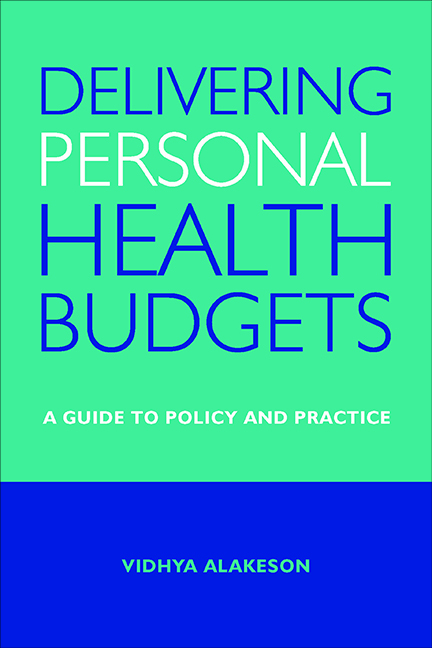Book contents
- Frontmatter
- Contents
- List of tables and figures
- Acknowledgements
- Prologue: Stephen’s story
- Introduction
- Section 1 Introducing personal health budgets
- Section 2 Implementing personal health budgets
- Section 3 Personal health budgets and organisational change in the NHS
- Conclusion
- Epilogue: Jonathan’s story
- References
- Index
three - The development of personalisation: from direct payments to personal health budgets
Published online by Cambridge University Press: 03 February 2022
- Frontmatter
- Contents
- List of tables and figures
- Acknowledgements
- Prologue: Stephen’s story
- Introduction
- Section 1 Introducing personal health budgets
- Section 2 Implementing personal health budgets
- Section 3 Personal health budgets and organisational change in the NHS
- Conclusion
- Epilogue: Jonathan’s story
- References
- Index
Summary
The decision to pilot PHBs in the NHS in England in 2009 can be traced back through a series of actors and events to the 1980s when disabled people, inspired by their peers in the US, started organising to move out of institutional care. However, there is not a straight line linking the campaigns of disabled people for independent living to PHBs. Rather, a set of related initiatives and interactions between disabled people, their allies, researchers and policymakers accounts for developments over the last 30 years. This chapter charts these developments to put PHBs in historical context.
Independent living and direct payments
Until the 1980s it was common for disabled people to be segregated from the rest of society in large institutional settings. At worst, these were hostile, abusive environments, more akin to prisons than a home. At best, they offered a uniform approach to care that left little room to cater to individual needs or preferences (Arnold, 2010). While recent abuse scandals have highlighted the importance of sustained pressure for quality improvement in residential care (DH, 2012a), services for disabled people are now oriented around supporting people to live as part of the wider community. The campaign for ‘independent living’ and the end of institutional care was pioneered by disabled people in the US whose influence spread to campaigners in the UK and in the rest of Europe. It took nearly 30 years, but the last long-stay institution for people with learning disabilities in the UK closed in 2009 (Mencap, 2009).
Within the disability movement, ‘independent living’ is defined as ‘all disabled people having the same choice, control and freedom as any other citizen – at home, at work, and as members of the community’ (DRC, 2002). A parallel movement made similar demands on behalf of people with mental health problems who were also consigned to appalling long-stay institutions. Like the ‘independent living’ movement, the ‘recovery’ movement was born out of the lived experience of people who had faced the challenge of living with and growing beyond a diagnosis of mental health problems (O’Hagan, 1993; Deegan, 1997).
- Type
- Chapter
- Information
- Delivering Personal Health BudgetsA Guide to Policy and Practice, pp. 31 - 44Publisher: Bristol University PressPrint publication year: 2014



